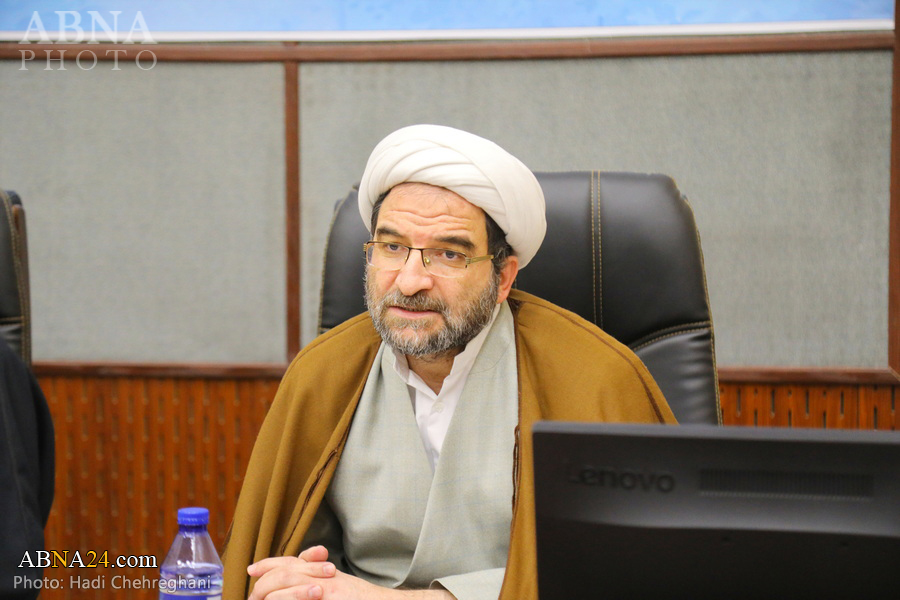The approach of Ibn Taymiyya and Salafis regarding the martyrdom of Imam Hussain (a.s.): Farmanian explained
Referring to the suspicion raised by Wahhabis that “Imam Hussain (a.s.) was killed by Shiites”, the expert on sects and denominations explained, “Ibn Taymiyya took a dual approach to the Karbala affair: on the one hand, accepting the martyrdom of Imam Hussain (a.s.), and on the other hand, blaming the Kufis for this murder and whitewashing Yazid.”
ABWA Official Website – On Tuesday, July 9, 2024, the seminar “Ashura from the perspective of Salafis” was held at the Islamic Sciences and Culture Academy, with the speech of Hojat al-Islam Mahdi Farmanian, Deputy for Cultural Affairs of the AhlulBayt (a.s.) World Assembly and an expert on sects and denominations.
An excerpt from this seminar is presented below.

What is the Salafis’ view about Ashura and how do they think about it? What is the Salafis’ interpretation of Ashura?
Before expressing the Salafis’ point of view about Ashura, it is better to have a definition of Salafism first. Unfortunately, due to the lack of a clear definition of Salafism, there are different definitions among researchers. Mostly, under the influence of Wahhabi propaganda and media, the followers of Salafism are defined as those who consider the understanding of the first three centuries of Islam (early Muslim) superior to the understanding of others and therefore prefer the understanding of the first three centuries over others. This is the definition that the Wahhabis put forward to connect themselves with the Companions.
But this is not a correct definition. Salafism includes those who are influenced by Ibn Taymiyya’s thoughts on the issue of the graves of divine saints (اولیاء الله). Therefore, we believe that the founder of Salafism is Ibn Taymiyya. One of the reasons for this, is that there is no school or denomination called Salafism in books of any sect and denomination written in the centuries before Ibn Taymiyyah, and Salafism is a new word. Even when Ibn Taymiyya coined the word, it was rarely used until a century ago, and the history of using “Salafism” goes back only about a hundred years. Therefore, the followers of Salafism are those who follow Ibn Taymiyya’s thoughts in the matter of the graves of divine saints and are influenced by his thoughts in monotheist theology. Therefore, they have no relation with the Salaf (predecessor or early Muslim).
Ibn Taymiyya’s dual approach regarding the martyrdom of Imam Hussain (a.s.)
As mentioned, we must first start with Ibn Taymiyya himself. How does Ibn Taymiyya view Ashura? In all his works, Ibn Taymiyya follows a dual approach, and he conveys this method to his followers. One of his approach is that he glorifies Imam Hussain (a.s.) and considers him to have virtues. Therefore, Ibn Taymiyya’s first step is to accept the Imam as a virtuous companion. Although he denies some of the virtues that the Shiites attribute to the Imam, he does not have any doubts about accepting the virtues of the Imam.
The second step that Ibn Taymiyya takes, is the acceptance of Imam Hussain’s (a.s.) martyrdom. That is, he admits that Imam Hussain (a.s.) was martyred. It is interesting that he also considers it permissible to curse the murderers of Imam Hussain (a.s.). However later, during some discussions, he does not consider a certain curse as permissible. That is, he believes that cursing a Muslim is not allowed until his disbelief is proven.
His next approach is to whitewash the Umayyads and Yazid and to defend them. So, who are the killers of Imam Hussain (a.s.) according to Ibn Taymiyya? People of Kufa, actually Shiites! Therefore, according to him, those who martyred Imam Hussain (AS) were the Shiites of Kufa! He asserts that Yazid did not order Ubaidullah to kill and martyr Imam Hussain (a.s.). While in history, something contrary to this claim has happened. Ibn Taymiyya says somewhere in his works that the Umayyads did not kill any of the Banu Hashim, and Zayd ibn Ali is only an exception.
Therefore, Ibn Taymiyya took a dual approach to the Karbala affair: on the one hand, accepting the martyrdom of Imam Hussain (a.s.), and on the other hand, blaming the people of Kufa for this murder and whitewashing Yazid. He even claims that the captive family of Imam Hussain (a.s.) was not taken to Syria after his martyrdom, and Yazid did not hit the Imam’s mouth and teeth with a stick, and these are the lies of history! We ask this question to the followers of Ibn Taymiyya: Ashura happened on the 10th of Muharram in 61 AH, and the captive family of Imam Hussain (a.s.) arrived in Medina eighty days later. Where were they during these eighty days? This behavior of Ibn Taymiyya has caused Sunnis to specify that he is Nasibi (someone who is hostile, and publicly displays his or her hostility, towards Imam Ali (a.s.) or other persons from AhlulBayt (a.s.)). Because he dedicates himself to the whitewashing Yazid and even has a book called “Ra’as al-Hussain” (The Head of Hussain: رأس الحسین) in which he denies many historical facts to prove that the head of Imam Hussain (a.s.) was not brought to the Levant and Damascus.
Who were the killers of Imam Hussain (a.s.)? People of Levant or Kufa?
The same approach continued by Wahhabism. Wahhabis wrote a book titled “Yazid, the Imam who was slandered!” No, these are not slanders, and many Sunni elders have narrated the history of Ashura and affirm what happened there. The guilt of Yazid and the people of Levant (Umayyads) is so clear and blatant that when Mukhtar al-Thaqafi asks Tawwabin (Penitents): “Are the killers of Imam Hussain (a.s.) in Kufa?” they answered: “No, the main enemy is the people of Levant, and we must fight them.” This shows that in the years 61 to 70, i.e. the 60s of Hijri, the people of Kufa considered the people of Levant as the main culprits, and Tawwabin went to war with the Levant.
Therefore, Wahhabis also have such thoughts and publish them in the media. Today, with the arrival of the month of Muharram every year, Wahhabi TV channels take the same approach and say: “Imam Hussain (a.s.) was a good person. But the Umayyads are not to blame (for Imam’s martyrdom), the Shiites are wrong. Shiites martyred Imam Hussain (a.s.) themselves, and they themselves are crying for him.” Several authors have proven in their works that such thinking is wrong.
As evidenced by history, most of those who came to Karbala against Imam Hussain (a.s.) had Uthmani thinking and were supporters of the Umayyads. The so-called Shiites of Kufa who wrote invitations to Imam Hussain (a.s.), mostly ran away in the middle of the way and did not come to the battle of Karbala. Therefore, it is true that the Shiites of Kufa wrote letters to the Imam. However, it should be noted that they were not adherent Shiites. Because they believed that Abu Bakr, Omar, and Ali were Caliphs and only Uthman was bad. These people were called Alavi. Because they preferred Ali (a.s.) over Uthman for Caliphate. On the other side were the supporters of Uthman, who are called Uthmanis. The Uthmanis or followers of Uthman had a grudge against the Alavis, and they were the same people who camr in Karbala and martyred Imam Hussain (a.s.).
In a nutshell, influenced by the thoughts of Ibn Taymiyya, the founder of Salafism, the followers of Salafism accept Imam Hussain (a.s.) as a virtuous man, and believe in the Imam’s martyrdom in the event of Ashura. But as far as they can, they either whitewash Yazid or remain silent and refrain from discussing the matter.
**************
End/ 345
Referring to the suspicion raised by Wahhabis that “Imam Hussain (a.s.) was killed by Shiites”, the expert on sects and denominations explained, “Ibn Taymiyya took a dual approach to the Karbala affair: on the one hand, accepting the martyrdom of Imam Hussain (a.s.), and on the other hand, blaming the Kufis for this murder and whitewashing Yazid.”
ABWA Official Website – On Tuesday, July 9, 2024, the seminar “Ashura from the perspective of Salafis” was held at the Islamic Sciences and Culture Academy, with the speech of Hojat al-Islam Mahdi Farmanian, Deputy for Cultural Affairs of the AhlulBayt (a.s.) World Assembly and an expert on sects and denominations.
An excerpt from this seminar is presented below.

What is the Salafis’ view about Ashura and how do they think about it? What is the Salafis’ interpretation of Ashura?
Before expressing the Salafis’ point of view about Ashura, it is better to have a definition of Salafism first. Unfortunately, due to the lack of a clear definition of Salafism, there are different definitions among researchers. Mostly, under the influence of Wahhabi propaganda and media, the followers of Salafism are defined as those who consider the understanding of the first three centuries of Islam (early Muslim) superior to the understanding of others and therefore prefer the understanding of the first three centuries over others. This is the definition that the Wahhabis put forward to connect themselves with the Companions.
But this is not a correct definition. Salafism includes those who are influenced by Ibn Taymiyya’s thoughts on the issue of the graves of divine saints (اولیاء الله). Therefore, we believe that the founder of Salafism is Ibn Taymiyya. One of the reasons for this, is that there is no school or denomination called Salafism in books of any sect and denomination written in the centuries before Ibn Taymiyyah, and Salafism is a new word. Even when Ibn Taymiyya coined the word, it was rarely used until a century ago, and the history of using “Salafism” goes back only about a hundred years. Therefore, the followers of Salafism are those who follow Ibn Taymiyya’s thoughts in the matter of the graves of divine saints and are influenced by his thoughts in monotheist theology. Therefore, they have no relation with the Salaf (predecessor or early Muslim).
Ibn Taymiyya’s dual approach regarding the martyrdom of Imam Hussain (a.s.)
As mentioned, we must first start with Ibn Taymiyya himself. How does Ibn Taymiyya view Ashura? In all his works, Ibn Taymiyya follows a dual approach, and he conveys this method to his followers. One of his approach is that he glorifies Imam Hussain (a.s.) and considers him to have virtues. Therefore, Ibn Taymiyya’s first step is to accept the Imam as a virtuous companion. Although he denies some of the virtues that the Shiites attribute to the Imam, he does not have any doubts about accepting the virtues of the Imam.
The second step that Ibn Taymiyya takes, is the acceptance of Imam Hussain’s (a.s.) martyrdom. That is, he admits that Imam Hussain (a.s.) was martyred. It is interesting that he also considers it permissible to curse the murderers of Imam Hussain (a.s.). However later, during some discussions, he does not consider a certain curse as permissible. That is, he believes that cursing a Muslim is not allowed until his disbelief is proven.
His next approach is to whitewash the Umayyads and Yazid and to defend them. So, who are the killers of Imam Hussain (a.s.) according to Ibn Taymiyya? People of Kufa, actually Shiites! Therefore, according to him, those who martyred Imam Hussain (AS) were the Shiites of Kufa! He asserts that Yazid did not order Ubaidullah to kill and martyr Imam Hussain (a.s.). While in history, something contrary to this claim has happened. Ibn Taymiyya says somewhere in his works that the Umayyads did not kill any of the Banu Hashim, and Zayd ibn Ali is only an exception.
Therefore, Ibn Taymiyya took a dual approach to the Karbala affair: on the one hand, accepting the martyrdom of Imam Hussain (a.s.), and on the other hand, blaming the people of Kufa for this murder and whitewashing Yazid. He even claims that the captive family of Imam Hussain (a.s.) was not taken to Syria after his martyrdom, and Yazid did not hit the Imam’s mouth and teeth with a stick, and these are the lies of history! We ask this question to the followers of Ibn Taymiyya: Ashura happened on the 10th of Muharram in 61 AH, and the captive family of Imam Hussain (a.s.) arrived in Medina eighty days later. Where were they during these eighty days? This behavior of Ibn Taymiyya has caused Sunnis to specify that he is Nasibi (someone who is hostile, and publicly displays his or her hostility, towards Imam Ali (a.s.) or other persons from AhlulBayt (a.s.)). Because he dedicates himself to the whitewashing Yazid and even has a book called “Ra’as al-Hussain” (The Head of Hussain: رأس الحسین) in which he denies many historical facts to prove that the head of Imam Hussain (a.s.) was not brought to the Levant and Damascus.
Who were the killers of Imam Hussain (a.s.)? People of Levant or Kufa?
The same approach continued by Wahhabism. Wahhabis wrote a book titled “Yazid, the Imam who was slandered!” No, these are not slanders, and many Sunni elders have narrated the history of Ashura and affirm what happened there. The guilt of Yazid and the people of Levant (Umayyads) is so clear and blatant that when Mukhtar al-Thaqafi asks Tawwabin (Penitents): “Are the killers of Imam Hussain (a.s.) in Kufa?” they answered: “No, the main enemy is the people of Levant, and we must fight them.” This shows that in the years 61 to 70, i.e. the 60s of Hijri, the people of Kufa considered the people of Levant as the main culprits, and Tawwabin went to war with the Levant.
Therefore, Wahhabis also have such thoughts and publish them in the media. Today, with the arrival of the month of Muharram every year, Wahhabi TV channels take the same approach and say: “Imam Hussain (a.s.) was a good person. But the Umayyads are not to blame (for Imam’s martyrdom), the Shiites are wrong. Shiites martyred Imam Hussain (a.s.) themselves, and they themselves are crying for him.” Several authors have proven in their works that such thinking is wrong.
As evidenced by history, most of those who came to Karbala against Imam Hussain (a.s.) had Uthmani thinking and were supporters of the Umayyads. The so-called Shiites of Kufa who wrote invitations to Imam Hussain (a.s.), mostly ran away in the middle of the way and did not come to the battle of Karbala. Therefore, it is true that the Shiites of Kufa wrote letters to the Imam. However, it should be noted that they were not adherent Shiites. Because they believed that Abu Bakr, Omar, and Ali were Caliphs and only Uthman was bad. These people were called Alavi. Because they preferred Ali (a.s.) over Uthman for Caliphate. On the other side were the supporters of Uthman, who are called Uthmanis. The Uthmanis or followers of Uthman had a grudge against the Alavis, and they were the same people who camr in Karbala and martyred Imam Hussain (a.s.).
In a nutshell, influenced by the thoughts of Ibn Taymiyya, the founder of Salafism, the followers of Salafism accept Imam Hussain (a.s.) as a virtuous man, and believe in the Imam’s martyrdom in the event of Ashura. But as far as they can, they either whitewash Yazid or remain silent and refrain from discussing the matter.
**************
End/ 345





